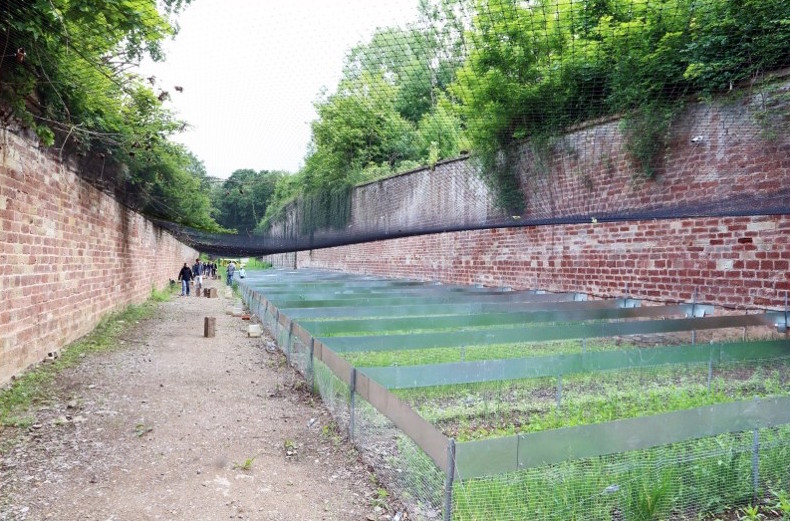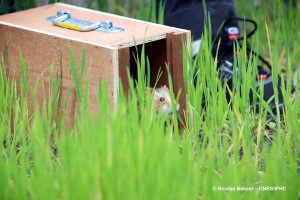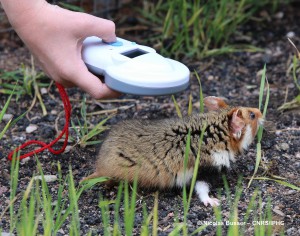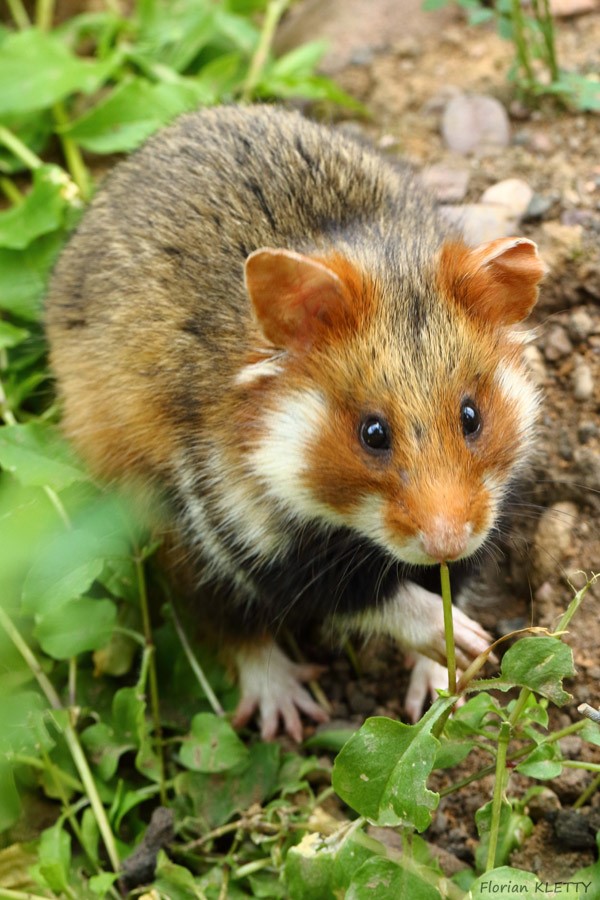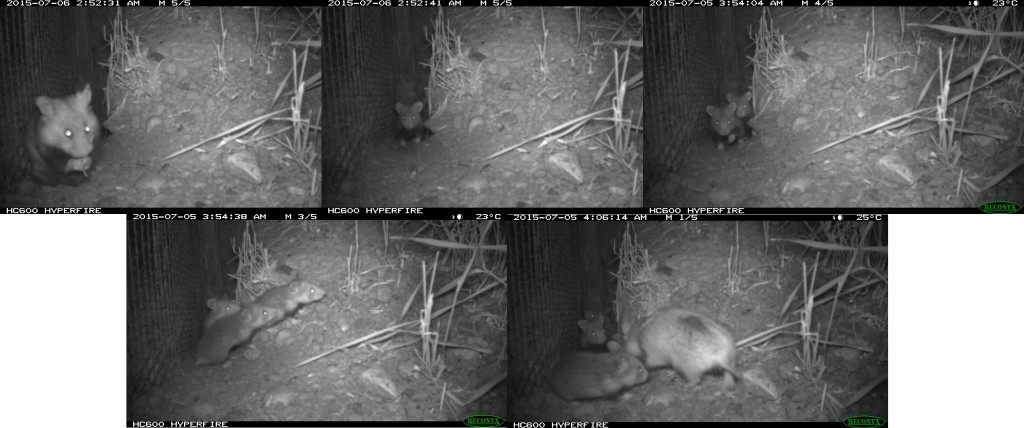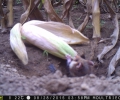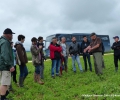Sowing several crops is good for biodiversity and encourages European Hamsters to reproduce
31 janvier 2018
The study carried out by the CNRS (French National Centre for Scientific Research) at Fort Joffre (see previous articles 1 and 2) within the scope of the LIFE Alister project has just been published in the scientific journal Oecologia 3. The results of this study reinforce the work undertaken by farmers in association with the CAA (Alsace Chamber of Agriculture) and ONCFS (French National Hunting and Wildlife Agency) in the Alister project.
Feedback on the CNRS study…
To assess the impact of corn, wheat and mixed crops on the hamster’s breeding habits and associated biodiversity,while disregarding predatory issues and the use of pesticides generally linked to conventional farming methods, the CNRS carried out a study in semi-natural conditions at Fort Joffre in 2015*.
Figure 1: Photo of the enclosures at Fort Joffre.
© Nicolas Busser – CNRS/IPHC.
For this study, 76 enclosures (Figure 1) were sown with corn, wheat , or a mix of crops (corn, wheat, sunflower and lucerne: the four crops were sown in rows). These enclosures were protected by netting and fences to make it impossible for predators to enter (both on the ground and from the air). In total, 36 hamsters (18 males and 18 females) were released (Figure 2) into the enclosures (6 couples, ie. 12 hamsters per crop type). Each hamster couple was allocated a 16m2 enclosure until mid-July. On this date, an opening was made in an adjoining enclosure, giving the hamsters the opportunity to search for food in this enclosure. From this date until the end of the study (September 2015), each hamster couple therefore had access to two enclosures with the same crop and a surface area of 32m2. The results showed that 36 enclosures were inhabited by hamsters, whereas 40 enclosures were uninhabited.
Figure 2: Photos of the hamsters being released at Fort Joffre.
© Nicolas Busser, CNRS/IPHC.
The released hamsters were monitored with infrared cameras, camera traps, by direct observation and capture. Simultaneously, the quantity and diversity of invertebrates and weeds were recorded in each enclosure (both where hamsters were present and absent), in order to assess: 1) the effect of sown crops on biodiversity and 2) the effect of hamsters on the quantity and diversity of weeds.
The results
The principal results of this study reveal that sowing a single crop (i.e. monoculture), irrespective of this being corn or wheat, is not compatible with the European Hamster’s needs and therefore has an adverse effect on its reproduction;; this remains true when predators are excluded and pesticides and mechanisation are not used (as in this case). The average number of young per female was < 1 in the ‘corn’ and ‘wheat’ enclosures, whereas it was > 3 in the ‘mixed’ enclosures (see Figure 3).
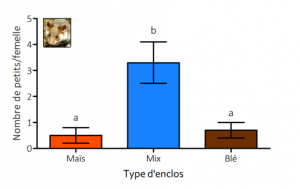 Figure 3: Average number of young per female in the enclosures at Fort Joffre according to crop type
Figure 3: Average number of young per female in the enclosures at Fort Joffre according to crop type
Letters ‘a’ and ‘b’ show significant differences (based on a statistical test) between the different types of enclosure. Figure taken from the article published in Oecologia, available here
The fact of sowing several crops (‘mixed’ enclosures) increased both the plant biodiversity (with a higher diversity of weeds; Figure 4) as well as the diversity and quantity of invertebrates, including some that are essential for healthy soils and pollination. An interesting fact concerning weeds which can be a drawback for agriculture when they compete with cultivated crops) is that there was a greater diversity in the ‘mixed’ enclosures without hamsters (compared to the ‘corn’ and ‘wheat’ enclosures), but not in the ‘mixed’ enclosures where hamsters were present (Figure 4).
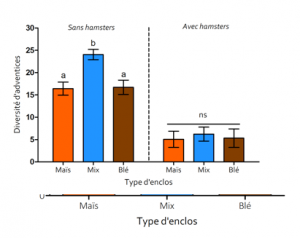
Figure 4: Weed diversity in the enclosures according to the crop type and the presence or absence of hamsters in the enclosure.
L. Letters ‘a’ and ‘b’ show significant differences (based on a statistical test) between the different types of enclosure, whereas ‘ns’ shows there is no difference. Figure taken from the article published in Oecologia , available here
CAbove, a photo of a hamster feeding on weeds in an enclosure at Fort Joffre.
These results (Figure 4) show that the hamsters act as weed ‘regulators’, due to their omnivorous diet. We noticed that the hamsters were particularly fond of certain weeds such as dandelions and poppies, which disappeared rapidly in the enclosures where hamsters were present. Furthermore, when other crops were available (in the ‘mixed’ enclosures only), the hamsters very rarely fed on the wheat and corn, which remained untouched in the main. This indicates that the green parts of these crops are not choice food for the hamsters and therefore not very suitable in the breeding season. Consequently, if other foodstuffs providing sufficient nutrition are available in their habitat (lucerne and sunflower), they will turn to these crops in preference. We must now study in what measure the presence of crop diversity within the hamster’s habitat (whether at the field edge, in nitrogen-fixing catch crops or by underseeding) may be able to reduce the damage made by hamsters on candidate crops (wheat, corn, etc).
In conclusion
Benefiting from a greater diversity of weeds, invertebrates and sown crops seems to have enabled the hamsters to fulfil their nutritional requirements in the ‘mixed’ enclosures and therefore to reproduce correctly (Figure 5; see also Figure 3); conversely, in the ‘corn’ and ‘wheat’ enclosures, the level of reproduction was too low for the species.
FFigure 5: Photo sequence of a female with a litter of 3 babies in a ‘mixed’ enclosure.
© IPHC – CNRS/Université de Strasbourg.
These results reinforce the trials carried out by farmers for the LIFE Alister project , in association with the CAA and the ONCFS, whose aim is to find solutions to diversify land cultivated with corn or wheat, by underseeding or by combining crops. The results also support trials of sowing crops similar to nitrogen-fixing catch crops on land with standing wheat where hamster populations develop each year.
1 : http://www.grand-hamster-alsace.eu/au-cnrs-on-seme-du/
2 : http://www.grand-hamster-alsace.eu/premiere-portee-hamsters-nes-en-semi-captivite
3 : https://link.springer.com/article/10.1007%2Fs00442-017-4025-y

